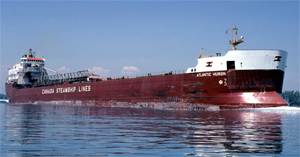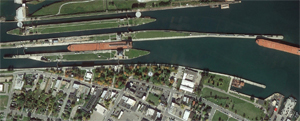A Great Lakes bulk carrier lost propulsion while approaching the Soo Locks in Sault Ste. Marie, Mich., and struck a pier separating two lock systems.
The incident happened at about 0300 on July 5 as Atlantic Huron prepared to enter Poe Lock from the west. The bulker, traveling at almost 7 knots, hit the west center pier separating the north and south canals.
Lt. Dan Peters, lead investigator for Coast Guard Sector Sault Ste. Marie, said Atlantic Huron’s crew dropped anchor before the impact. The ship struck the pier at a “glancing angle” rather than head on, he added.
The 736-foot ship “had a momentary loss of propulsion” before striking the wall, Peters said. Specifics about the propulsion failure are subject to an ongoing investigation and could not be released.
The Soo Locks opened in 1855. They are located in the St. Marys River at the northern end of Michigan’s Upper Peninsula, at the border with Ontario, Canada. Poe Lock opened in 1969, just north of MacArthur Lock. These two locks are the primary connection between Lake Superior and Lake Huron.
About 4,500 cargo ships transit the Poe and MacArthur locks each year carrying 80 million tons of material, according to the U.S. Army Corps of Engineers, which operates the locks. Another 2,500 recreational and tour boats move through the facility. Nearly 90 percent of the commercial tonnage passes through Poe Lock, said Kevin Sprague, area engineer for the Army Corps.
 |
|
Atlantic Huron, shown on the St. Clair River, struck the west end of the pier separating Poe from Davis Lock (second lock from the top). MacArthur Lock is below Poe. |
|
Pverdonk |
The Canada-flagged Atlantic Huron had departed from Thunder Bay, Ontario, on Lake Superior without cargo. It approached Poe Lock from the west for downbound transit. The ship struck the south face of the west center pier, pushing the concrete pier cap out of position. Mooring bollards installed within the concrete pier also were dislodged.
“It moved about 6 inches, and that is a problem,” Sprague said of the concrete pier cap. “When the concrete shifted, it pushed the bollards.”
The extent of any damage below the surface was not immediately available. Sprague expected divers to begin their survey in mid-July to determine any issues to the sheet pile face. The total cost of repairs, he said, was not yet known and would depend on what the divers find.
Ship operator Canada Steamship Lines arranged for tugboats to move Atlantic Huron out of the canal leading toward the locks. The tugs towed the ship back into Canadian waters. Surveyors also scanned the river bottom to make sure the anchor did not drag any boulders into the 30-foot-deep channel.
“Ship traffic was blocked for several hours, but they were able to move (Atlantic Huron) to a different location to enable ships to come through,” Peters said.
The 36-year-old self-unloading bulker sustained dents on the port bow where it made contact with the wall. The hull did not breach, and there was no pollution. No one on board was injured.
Canada Steamship Lines declined to comment during the ongoing investigation. As of July 14, AIS data showed the vessel underway from Sault Ste. Marie back to Thunder Bay. It is not clear if the vessel needed immediate repairs.

